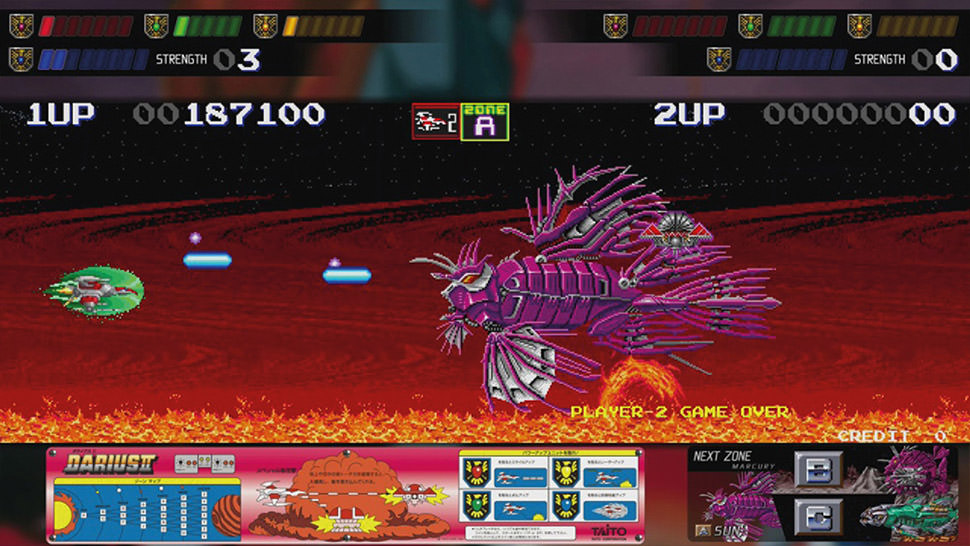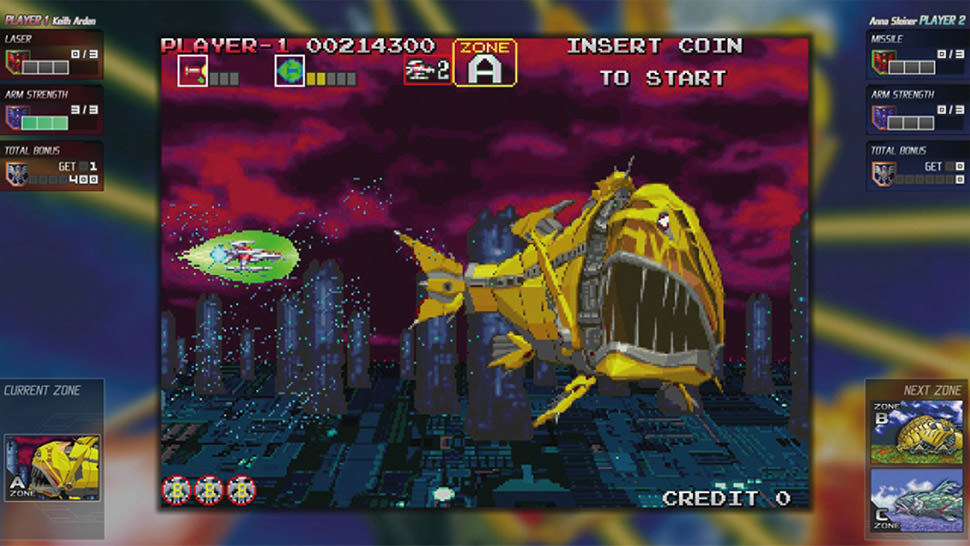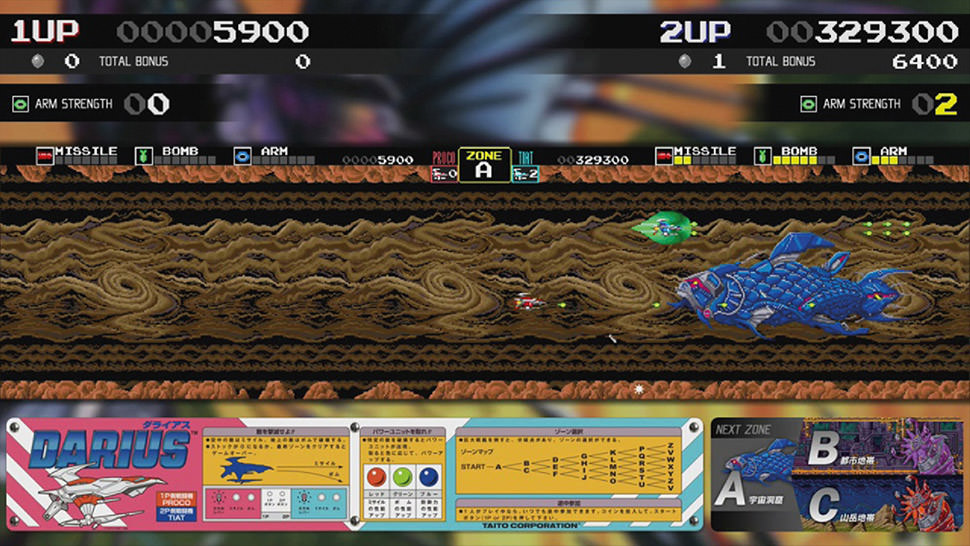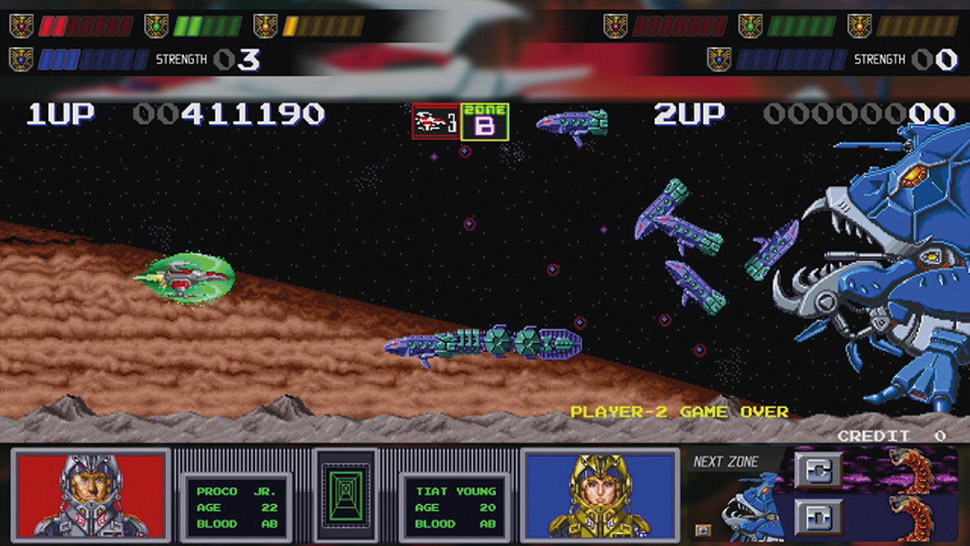Darius Cozmic Collection Arcade Review

 By Kevin Mitchell | Jun 29, 2020
By Kevin Mitchell | Jun 29, 2020
Taito's shoot 'em up series Darius forever changed the arcade landscape when it released the first game in early 1987 (although the copyright in the game is noted as 1986). Darius, with its intense bullet-hell-like gameplay and innovative three-screen monitor cabinet, captivated audiences. I've already reviewed the console collection released on PlayStation 4, and while most of the ports were more than adequate, the original games played better in the arcades. Darius Cozmic Collection Arcade features seven different versions of four titles: the first three Darius games and the localized version renamed to SAGAIA.

If you haven't checked out the review for the console collection, I highly recommend it, but I'll also cover the Darius series basics here. As a side-scrolling shoot 'em up, you'll pilot a Silver Hawk, the only ship capable of fighting back against the vile Belsar invasion. The invading forces are highly sentient robotic ships designed after marine biology: fish, crustaceans, sea horses, octopuses, etc. The recurring boss (and fan favorite), King Fossil, is designed after a coelacanth. The home console ports feel different from the arcade games, mainly due to being altered to fit a single-screen display, not to mention consoles had weaker hardware than arcades. The first game wasn't even directly ported to the more popular platforms at the time. The PC Engine received Super Darius, which featured additional content that was initially cut; however, it wasn't made available in the console collection. Darius Plus is a lighter version of Super Darius, being produced on a HuCard instead of CD-ROM.
The original Darius is a classic; however, the gameplay improvements and advancements in the sequel laid the groundwork for future titles. In Darius Cozmic Collection Arcade, there are three versions of Darius: original (or old), new, and extra. The old version represents the first arcade release if you were lucky enough to play the fantastic cabinet. The on-screen play area occupies only a small slice of the screen (mimicking the three-screen setup), even on a large television. Playing on a 4K 55-inch display, I couldn't imagine attempting to play through the game on anything smaller. As you successfully navigate through zones and defeat the boss, you're presented with a choice of two new zones in a fan-shaped map. This means you'll only play seven zones in any given run out of the possible 28. Unlike the sequels, once your ship is destroyed, you don't instantly respawn; instead, the game fades to black, respawning you at a checkpoint without any of your upgraded weapons or armor. Shooting specially marked enemies produces power-ups in the form of floating orbs. Red orbs improve your forward-facing missiles, green for your bombs, and blue for your armor. Armor is the only thing that can protect you from being destroyed after taking a single hit. If you collect enough of any one category, you'll advance to a new tier. Even upon death, you'll spawn at this new tier instead of at the weakest level.

The new version of Darius rebalances the gameplay, making boss encounters easier if you have advanced your primary weapon's tier. In the original, reaching a new tier meant bosses received additional health to prevent players from defeating them too quickly. The new version lets you feel like an unstoppable machine if you're lucky enough to collect that many power-ups. Darius: Extra Version, released only in Japan in a limited capacity, adds extra enemies and alters their formations. It's also the first version that lets players insert additional money when they lose all their lives to continue playing. It was disabled once you reached the final zone, which I'm sure caused many kids at the time to curse loudly.
Two years after the release of Darius, Taito brought Darius II to arcades. The game was designed for multiple screens, allowing it to be played in the original Darius cabinet; however, it was more widely available in a dual-screen cabinet. Significant improvements occurred during boss encounters, as the player's ship could change orientation depending on its position relative to the boss. The Silver Hawk received new weaponry, such as upwards and downwards firing lasers. The weapon tier system was removed, resulting in the loss of all power-ups upon death. The game also added more robust engagements during every stage, serving as mid-boss battles. When localized overseas, it was released as SAGAIA using the dual-screen cabinet. It was believed that Western audiences wouldn't enjoy the longer stages, so they were shortened. The difficulty was raised to balance the newer, faster zones. Based on the Collection, there are two different versions of the game; however, no information could be found about version 2, which may not have been released.

The final game, Darius Gaiden, is without doubt my favorite in the Collection, and even after playing all the console ports, it's probably my favorite in the franchise. Released in 1994, it was designed for single-screen cabinets, a series first in the arcades. Using a standardized cabinet meant the game could reach a wider variety of locations, especially those that lacked space for the massive dual or triple-screen cabinets. As the third entry in the series and fifth game overall, Darius Gaiden was ported to many platforms, including Sega Saturn, PlayStation, Windows, PlayStation 2, and Xbox. It stunned audiences with parallax scrolling and visual effects, creating an almost 3D appearance in the environments. A new feature introduced in Darius Gaiden is the ability to capture mid-bosses. The capture process was simple but required precise accuracy to dislodge a small circular ball attached to their body without destroying them. If it breaks free and you collect it, the mid-boss temporarily follows you around. The black hole bomb was added to your arsenal, sucking up both enemy projectiles and ships for a short period. It's a great equalizer when you find yourself heavily outnumbered and overwhelmed.

Simply Put
Darius Cozmic Collection Arcade may have fewer titles than the console collection; however, the original arcade games are a pleasure to play. It's odd that G-Darius was omitted, as it's the only arcade game not included in either release. Darius II and Darius Gaiden still hold up today, and Gaiden feels like a natural progression from its predecessor. I'm not sure we needed three versions of Darius and two of SAGAIA, especially considering I can't find any information about what was different in version two.
Note: Darius Cozmic Collection Arcade was reviewed on PlayStation 4. A digital copy of the game was provided by the publisher/developer.




